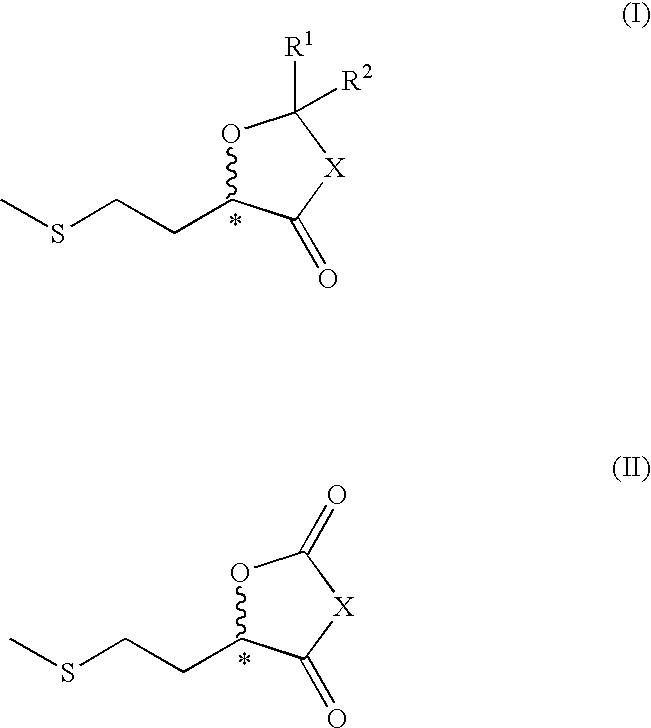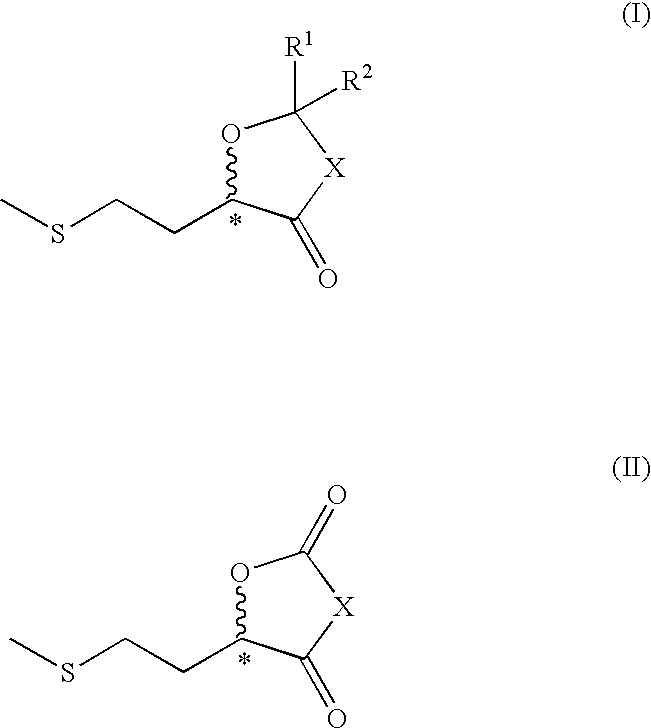2-methylthioethyl-substituted heterocycles as feed additives
a technology of heterocycles and feed additives, which is applied in the field of 2methylthioethylsubstituted heterocycles, can solve the problems of high cost, no longer economically efficient, and ineffective ruminant feed supply with methionine,
- Summary
- Abstract
- Description
- Claims
- Application Information
AI Technical Summary
Benefits of technology
Problems solved by technology
Method used
Image
Examples
example 1
Synthesis of 5-(2-(methylthio)ethyl)-1,3-dioxolan-4-one (2) from 2-hydroxy-4-(methylthio)butanoic Acid Calcium Salt (1) and Formalin Solution by Brönstedt Acid Catalysis in a Two-Phase Mixture
[0070]
[0071]10.0 g (29.5 mmol) of 2-hydroxy-4-(methylthio)butanoic acid calcium salt (1) were placed in a 500 mL three-neck round bottom flask in 150 mL of water and 150 mL of toluene and admixed with 3.5 g (34.6 mmol) of 97% strength sulfuric acid. After addition of 50 g (0.58 mol, 19.6 eq.) of 37% strength formalin solution, the mixture was heated to boiling temperature and stirred for 16 h at this temperature. After it was cooled, the phases were separated and the aqueous phase was washed twice, each time with 50 mL of toluene. The combined organic phases were washed once with 50 mL of NaCl solution, dried over MgSO4 and concentrated on a rotary evaporator. The resultant crude product was subsequently distilled (boiling point=125° C. / 1.5 mbar). This produced 7.7 g (47.6 mmol, yield=81%) of 5...
example 2
Synthesis of 5-(2-(methylthio)ethyl)-1,3-dioxolan-4-one (2) from 2-hydroxy-4-(methylthio)butanoic Acid (3) and Trioxane or Paraformaldehyde by Brönstedt Acid Catalysis
[0075]
[0076]5.0 g (33.3 mmol) of 2-hydroxy-4-(methylthio)butanoic acid (3) and 5.0 g (55.5 mmol, 1.67 eq.) of 1,3,5-trioxane (alternatively 5.0 g of paraformaldehyde) were placed in a 100 mL three-neck round bottom flask in 50 mL of toluene, admixed with a spatula tip of p-toluenesulfonic acid and heated to boiling. After 12 h, the solvent was distilled off on a rotary evaporator and the resultant crude product was distilled in vacuum. This produced 4.6 g (28.5 mmol, yield=86%) of 5-(2-(methylthio)ethyl)-1,3-dioxolan-4-one (2) as colorless liquid. The NMR data agreed with those from Example 1.
example 3
Synthesis of 2,2-dimethyl-5-(2-(methylthio)ethyl)-1,3-dioxolan-4-one (4) from 2-hydroxy-4-(methylthio)butanoic Acid (3) and Acetone by Brönstedt Acid Catalysis
[0077]
[0078]5.0 g (33.3 mmol) of 2-hydroxy-4-(methylthio)butanoic acid (3) were placed in a 250 mL three-neck round bottom flask in 100 mL of acetone, admixed with a few drops of trifluoromethanesulfonic acid or sulfuric acid and stirred at RT for 16 h. Subsequently the reaction mixture was concentrated on a rotary evaporator, taken up into 100 mL of diethyl ether and extracted twice, each time with 25 mL of saturated NaCl solution. The ether phase was dried over MgSO4, concentrated on a rotary evaporator and the resultant crude product subsequently distilled in vacuum via a Vigreux column (boiling point=122° C. / 1 mbar). This produced 5.2 g (27.4 mmol, yield=82%) of 2,2-dimethyl-5-(2-(methylthio)ethyl)-1,3-dioxolan-4-one (4) as colorless oil.
[0079]1H-NMR of 2,2-dimethyl-5-(2-(methylthio)ethyl)-1,3-dioxolan-4-one (4) (500 MHz, ...
PUM
| Property | Measurement | Unit |
|---|---|---|
| time | aaaaa | aaaaa |
| acid or | aaaaa | aaaaa |
| chemical | aaaaa | aaaaa |
Abstract
Description
Claims
Application Information
 Login to View More
Login to View More - R&D
- Intellectual Property
- Life Sciences
- Materials
- Tech Scout
- Unparalleled Data Quality
- Higher Quality Content
- 60% Fewer Hallucinations
Browse by: Latest US Patents, China's latest patents, Technical Efficacy Thesaurus, Application Domain, Technology Topic, Popular Technical Reports.
© 2025 PatSnap. All rights reserved.Legal|Privacy policy|Modern Slavery Act Transparency Statement|Sitemap|About US| Contact US: help@patsnap.com



